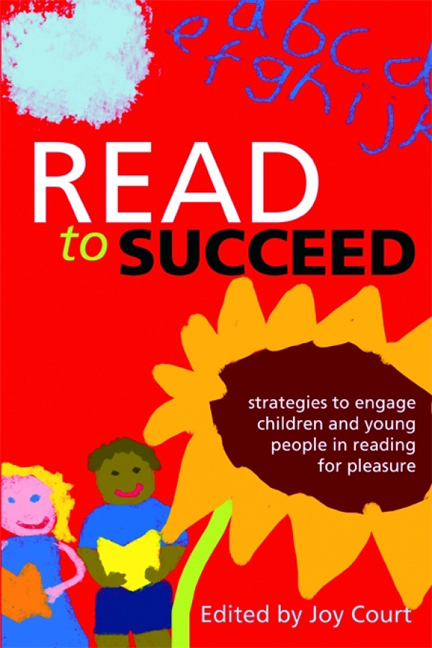Book contents
- Frontmatter
- Dedication
- Contents
- Foreword
- Contributors
- Introduction
- 1 It's never too soon to start
- 2 How children begin to read
- 3 Creating young readers: teachers and librarians at work
- 4 The six dimensions of the ‘honeycomb’ model, and its implications for literacy, libraries and literature in New Zealand
- 5 The Summer Reading Challenge in libraries: a continuing success
- 6 Stockport does Book Idol! A case study linking libraries and schools to inspire reading for pleasure
- 7 There and back again: restoring reading to the classroom
- 8 Promoting excellence: shadowing the CILIP Carnegie and Kate Greenaway Medals
- 9 Choice and motivation: local book awards
- 10 The sport of reading
- 11 Adventures in the book trade: libraries and partnerships
- 12 The hard-to-reach reader in the 21st century
- 13 Creative reading and insideadog.com.au
- Index
- Miscellaneous Endmatter
- Miscellaneous Endmatter
- misc-endmatter
4 - The six dimensions of the ‘honeycomb’ model, and its implications for literacy, libraries and literature in New Zealand
Published online by Cambridge University Press: 08 June 2018
- Frontmatter
- Dedication
- Contents
- Foreword
- Contributors
- Introduction
- 1 It's never too soon to start
- 2 How children begin to read
- 3 Creating young readers: teachers and librarians at work
- 4 The six dimensions of the ‘honeycomb’ model, and its implications for literacy, libraries and literature in New Zealand
- 5 The Summer Reading Challenge in libraries: a continuing success
- 6 Stockport does Book Idol! A case study linking libraries and schools to inspire reading for pleasure
- 7 There and back again: restoring reading to the classroom
- 8 Promoting excellence: shadowing the CILIP Carnegie and Kate Greenaway Medals
- 9 Choice and motivation: local book awards
- 10 The sport of reading
- 11 Adventures in the book trade: libraries and partnerships
- 12 The hard-to-reach reader in the 21st century
- 13 Creative reading and insideadog.com.au
- Index
- Miscellaneous Endmatter
- Miscellaneous Endmatter
- misc-endmatter
Summary
Introduction: the New Zealand context for literacy
It is argued in this chapter that New Zealand's reputation as a ‘highly literate and print-orientated society’ (Wilkinson, 1998, 144) has been due in part to the isolation and independence borne originally of our geographical position or ‘islandness’ and, through the 20th century in particular, to a strong ‘home grown’ literacy teaching and learning pedagogy in our schools, high rates of library membership, newspaper and magazine readership, a strong commitment to the wide canon of literature and, more recently, to our own burgeoning adult and children's literature.
The argument, however, has been sorely tested in recent times. Like many other countries in the Organisation for Economic Co-operation and Development, New Zealand has been challenged to maintain literacy standards in English in the face of worldwide instantaneous communication, globalization and access to popular culture, mobility and mass migration, socio-lingual and cultural diversity and, more recently, effects on the literacy achievement of those most likely to struggle in times of economic constraint. To add complexity to an already challenging field, the very notion of what it means to be literate has shifted from simply being able to read and write to the wider concept of literacies: the range of functional, academic, ‘new literacies’, multi-literacies and critical ways of ‘reading the world’ (Freire and Macedo, 1987; Gee, 2008; Healy, 2008; Kalantzis, Cope and Cloonan, 2010; Lankshear and Knobel, 2003; Leu, 2000; Wink, 2010).
Healy encapsulates this shift in emphasis when she suggests:
Many students in their everyday lives connect to an array of texts that bear little resemblance to the book, and to a vast digital network that transcends more traditional forms of text. Of particular concern to the focus of this discussion are issues surrounding access to information, and to the libraries that typically support inquiry learning.
(Healy, 2008, 1)Libraries and librarians have now the opportunity, and the obligation, to powerfully reassert their place as key information providers in classrooms, schools, communities and homes as the intersecting lines of knowledge, skills and communication and the literacy curriculum, inquiry processes and information resources become the pivotal drivers of 21st-century life.
- Type
- Chapter
- Information
- Read to SucceedStrategies to Engage Children and Young People in Reading for Pleasure, pp. 49 - 70Publisher: FacetPrint publication year: 2011



